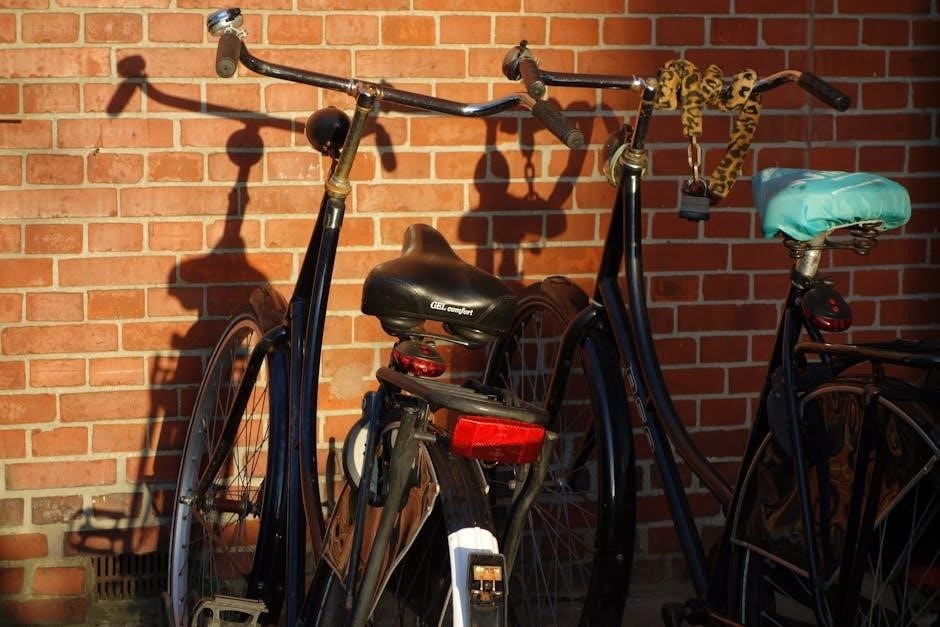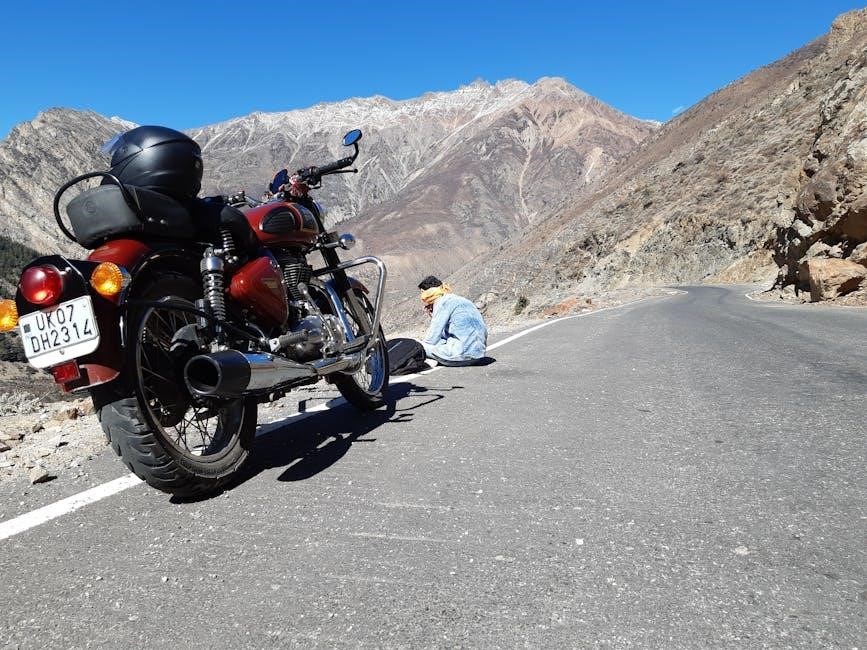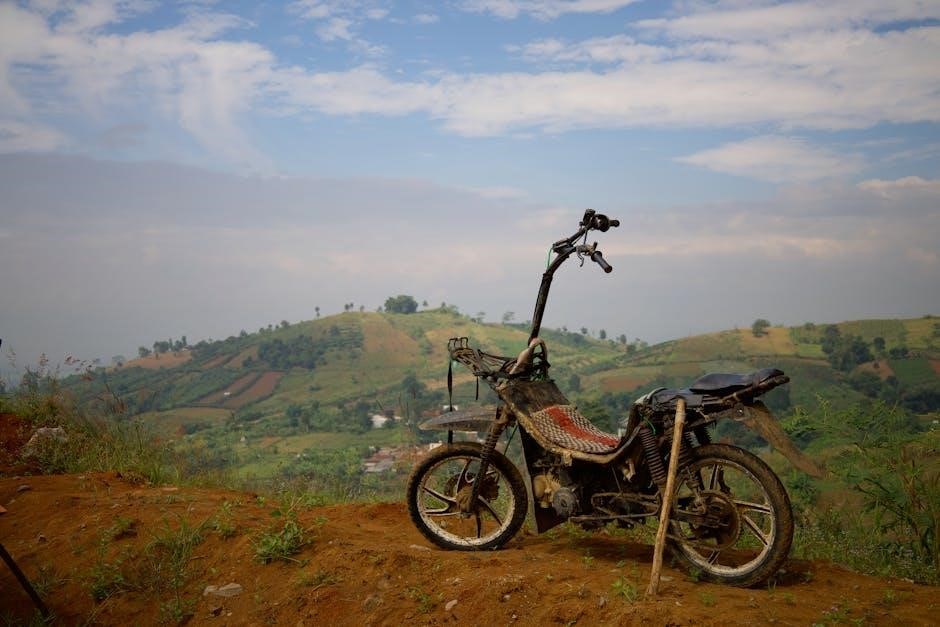
bike buying guide
Buying a bike can be an exciting but overwhelming experience. Start by identifying your cycling needs‚ setting a budget‚ and understanding the importance of proper fit. These steps will guide you toward making an informed decision‚ ensuring your bike is both functional and enjoyable for years to come.
1.1 Understanding Your Cycling Needs
Identifying your cycling needs is the first step in buying the right bike. Consider how often you’ll ride‚ the terrain you’ll cover‚ and your primary purpose—whether it’s commuting‚ recreation‚ fitness‚ or adventure. Roads‚ trails‚ or urban streets each require different bike types. Reflect on your lifestyle and preferences to narrow down your options. For instance‚ if you’ll ride mainly on paved paths‚ a road or hybrid bike might be ideal. If you plan to tackle rough trails‚ a mountain or gravel bike is more suitable. Your cycling goals and habits will help you choose a bike that aligns with your needs and enhances your riding experience.
1.2 Setting a Budget
Setting a budget is crucial when buying a bike‚ as prices vary widely depending on type‚ quality‚ and features. Determine how much you’re willing to spend upfront‚ considering your cycling frequency and needs. Entry-level bikes typically cost between $300-$800‚ while high-end models can exceed $5‚000. Consider whether you need accessories like helmets‚ locks‚ or lights‚ as these add to the total cost. Used bikes can be a cost-effective option‚ offering good value if maintained properly. Stick to your budget to avoid overspending and ensure your purchase aligns with your financial comfort zone. A well-defined budget helps narrow down options and simplifies decision-making.
1.3 Importance of Proper Fit
A proper bike fit is essential for comfort‚ efficiency‚ and safety. A bike that doesn’t fit well can lead to discomfort‚ fatigue‚ or even injuries during long rides. Standover height‚ saddle height‚ and handlebar reach are critical factors to consider. Ensure there’s adequate clearance when standing over the bike and that the saddle height allows a slight bend in your knee when the pedal is at its lowest point. Handlebars should be at a height that allows a neutral spine and comfortable grip. A well-fitted bike enhances performance and enjoyment‚ making every ride more satisfying and stress-free.

Types of Bikes
From road bikes to mountain‚ gravel‚ and commuter bikes‚ each type is designed for specific riding conditions and preferences‚ ensuring optimal performance and enjoyment for cyclists.
2.1 Road Bikes
Road bikes are designed for speed and efficiency on paved surfaces. They feature lightweight frames‚ narrow tires‚ and aerodynamic geometry‚ making them ideal for racing‚ fitness‚ or long-distance rides. Drop handlebars allow for multiple hand positions‚ reducing fatigue‚ while the gearing system provides a wide range of speeds for varying terrain. These bikes are perfect for riders seeking a fast‚ responsive experience on roads or bike paths. If your primary goal is speed and performance on smooth surfaces‚ a road bike is an excellent choice. They are also great for training and building endurance‚ making them a popular option for serious cyclists.
2.2 Mountain Bikes
Mountain bikes are built for off-road adventures‚ featuring sturdy frames‚ wide tires with aggressive tread‚ and suspension systems to handle rough terrain. They are designed for durability and control on trails‚ with flat or riser handlebars for better maneuverability. suspension systems‚ such as hardtail or full-suspension‚ absorb shocks from rocks and bumps. Mountain bikes are categorized by their intended use‚ such as cross-country‚ trail‚ enduro‚ or downhill riding. If you plan to ride on unpaved paths‚ mountains‚ or challenging terrains‚ a mountain bike is the ideal choice. Its robust construction and versatile features make it perfect for exploring nature and tackling demanding trails.
2.3 Hybrid Bikes
Hybrid bikes are a versatile option‚ blending the best features of road and mountain bikes. They are designed for commuting‚ casual rides‚ and light off-road adventures. With an upright riding position and comfortable geometry‚ hybrid bikes are ideal for riders seeking relaxation and practicality. Their frames are often made of aluminum or steel‚ offering durability and ease of handling. Tires are typically wider than road bikes but narrower than mountain bikes‚ providing a balance of efficiency and traction on various surfaces. Hybrid bikes are perfect for city streets‚ bike paths‚ and light trails‚ making them a great choice for everyday use or recreational riding.
2.4 Gravel Bikes
Gravel bikes are designed for adventure and versatility‚ excelling on a mix of surfaces such as paved roads‚ dirt paths‚ and gravel trails. They feature a lightweight frame‚ often made of aluminum‚ carbon‚ or steel‚ with a geometry similar to road bikes but with a more relaxed fit. Wider tires‚ typically between 35-50mm‚ provide excellent traction and comfort on uneven terrain. Gravel bikes are equipped with disc brakes for reliable stopping power and often include mounts for racks and fenders‚ making them ideal for long-distance touring or bikepacking. Their drop handlebars allow for multiple hand positions‚ combining efficiency with control‚ making them a favorite for explorers seeking both on-road efficiency and off-road capability.
2.5 Commuter Bikes
Commuter bikes are designed for practicality and ease of use‚ making them ideal for daily rides in urban environments. They typically feature lightweight frames‚ often made of aluminum or steel‚ and are equipped with straight or flat handlebars for an upright riding position that reduces strain and improves visibility. These bikes prioritize reliability and durability‚ with features like fenders to protect against wet conditions and racks for carrying gear. While not built for speed‚ commuter bikes offer a comfortable and efficient way to navigate city streets. Many models also include mounts for accessories like lights and panniers‚ enhancing their versatility for everyday use.
2.6 Cruiser Bikes
Cruiser bikes are designed for relaxed‚ enjoyable rides on flat terrain‚ such as beaches‚ parks‚ or bike paths. They feature a low standover height‚ single-speed or 3-speed drivetrains‚ and wide‚ comfortable saddles. The upright handlebars and laid-back geometry promote a stress-free riding position‚ making them perfect for casual outings. Cruiser bikes often have a retro or vintage aesthetic‚ appealing to riders who prioritize style and comfort over speed. They are lightweight‚ easy to maintain‚ and ideal for short‚ leisurely rides. Accessories like baskets and fenders are common‚ enhancing their practicality for running errands or enjoying a scenic ride without the need for high performance.
2.7 Electric Bikes
Electric bikes‚ or e-bikes‚ are an excellent choice for commuting and fitness‚ offering a blend of effort and assistance. They feature pedal-assist or throttle-activated motors‚ enabling riders to cover longer distances with less exertion. E-bikes are versatile‚ suitable for various terrains‚ and ideal for those seeking a convenient‚ eco-friendly transport option. While they are generally more expensive than traditional bikes‚ their efficiency and comfort make them a worthwhile investment. Maintenance costs may be higher due to the battery and motor‚ but e-bikes provide unmatched convenience and ease of use‚ making them a popular choice for modern cyclists.
2.8 Folding Bikes
Folding bikes are designed for portability and convenience‚ perfect for urban commuting and storage in tight spaces. They are lightweight and feature a compact foldable frame‚ allowing easy transport on public transport or storage in small apartments; Ideal for short to medium-distance rides‚ folding bikes are practical and versatile. While they may not offer the same speed as road bikes‚ their convenience and durability make them a great option for city dwellers. Maintenance is generally straightforward‚ and they are cost-effective for those needing a reliable‚ space-saving bicycle. Folding bikes are an excellent choice for those prioritizing practicality and ease of use.
Key Components to Consider
When buying a bike‚ focus on frame materials‚ gearing‚ wheels‚ brakes‚ and saddle comfort. These components affect performance‚ durability‚ and ride quality‚ ensuring optimal functionality for your cycling needs.
3.1 Frame Materials
Frame materials significantly impact a bike’s performance‚ weight‚ and durability. Common options include aluminum‚ known for its lightweight and affordability‚ and carbon fiber‚ prized for its strength and stiffness. Steel frames offer a smooth ride and are often used in custom builds‚ while titanium balances durability and lightness. Each material caters to different riding styles and preferences‚ making it essential to choose based on your intended use and budget; Understanding these options ensures your bike aligns with your cycling goals‚ whether racing‚ commuting‚ or trail riding.
3.2 Gearing and Drivetrain
Gearing and drivetrain are crucial for optimizing your cycling experience. The type and number of gears determine how smoothly you can tackle different terrains. Road bikes often feature 2×11 or 2×12 drivetrains for precise shifting‚ while mountain bikes use wider-range cassettes for climbing. Hybrid and commuter bikes may have internal gear hubs for low maintenance. Derailleurs and chainrings are traditional‚ but some bikes now use belt drives or single-speed setups. Ensuring compatibility between components is key for efficient pedaling and gear changes. Consider your riding style and terrain to choose the right gearing system for your needs.
3.3 Wheels and Tires
Wheels and tires play a significant role in your bike’s performance and comfort. Road bikes typically feature lightweight‚ narrow wheels for speed‚ while mountain bikes have wider‚ knobby tires for traction on rough terrain. Hybrid and commuter bikes often use versatile‚ medium-width tires for a balance of efficiency and durability. Tire material and tread pattern also matter‚ with options like slick‚ semi-slick‚ or knobby designs. Consider the width and pressure rating for your riding style‚ as wider tires offer more comfort but may reduce speed. Proper maintenance‚ such as regular inspections and inflation‚ ensures longevity and safety. Tubeless tires are gaining popularity for their puncture resistance and smoother ride.
3.4 Brakes
Brakes are a critical component for safety and control. Rim brakes are commonly found on road bikes‚ offering simplicity and light weight‚ while disc brakes provide superior stopping power in wet and rough conditions. Hydraulic disc brakes deliver consistent performance‚ though they are heavier and more complex. For mountain and hybrid bikes‚ disc brakes are highly recommended due to their reliability. Maintenance is essential; ensure pads are clean‚ rotors are aligned‚ and cables are tight. Test your brakes before every ride to guarantee optimal function. Upgrading to higher-quality brake systems can enhance safety and confidence‚ especially for aggressive or downhill riding.
3.5 Saddle and Handlebars
The saddle and handlebars are crucial for comfort and control. Saddles come in various shapes and widths to suit different riding styles and body types. Racing saddles are narrow for efficiency‚ while comfort saddles are wider for leisurely rides. Handlebars vary by type: drop bars for road bikes‚ flat bars for hybrids‚ and riser bars for mountain bikes. Ergonomic grips and adjustable handlebar height can reduce strain. Test different setups during a test ride to ensure comfort. Upgrading to a high-quality saddle or ergonomic handlebars can significantly enhance your riding experience and reduce fatigue over long distances.

Sizing and Fit
Proper bike fit ensures comfort and efficiency. Measure your inseam and compare it to the standover height. Adjust the saddle height for a slight knee bend when the pedal is at its lowest point. Handlebars should align with your comfort‚ whether upright or aggressive. A well-fitted bike reduces strain and enhances performance‚ making every ride enjoyable and injury-free.
4.1 How to Measure Your Bike Size
Accurate bike sizing ensures comfort and efficiency. Start with standover height: stand over the bike with feet flat‚ and there should be 1-2 inches of clearance for road bikes and 2-4 inches for mountain bikes. Measure your inseam by standing against a wall with a book pressed upwards. This helps determine saddle height. Use manufacturer size charts‚ which often base sizing on frame dimensions. Consider personal comfort and riding style‚ as some riders prefer a slightly different fit. Testing a bike in person is ideal‚ but online calculators can provide a good estimate if shopping remotely.
4.2 Adjusting Your Bike for Comfort
A proper bike fit is crucial for comfort and performance. Start by adjusting the saddle height to ensure your leg is nearly fully extended at the pedal’s lowest point. Handlebars should align with your comfort—raise them for a more upright position or lower for aerodynamics. fine-tune the saddle position by sliding it forward or backward to avoid strain on your hands and wrists. If using clipless pedals‚ position cleats on your shoes to optimize pedaling efficiency. Test the bike by riding it to ensure no discomfort or strain. Small adjustments can make a big difference in your overall cycling experience.
4.3 Importance of Standover Height
Standover height is a critical factor in ensuring a safe and comfortable riding experience. It refers to the clearance between your inseam and the bike’s top tube when standing over the frame. Proper standover height prevents injuries in the event of an unexpected dismount or obstacle. A general rule is to have at least 1-2 inches of clearance for road bikes and 2-4 inches for mountain bikes. This allows for easy maneuverability and reduces the risk of hitting the frame. Always test standover height with your cycling shoes on to get an accurate measurement and ensure optimal safety and comfort.

Buying Options
Buying a bike involves deciding between new or used‚ local shops or online retailers‚ and considering test rides. Each option has pros and cons‚ so research and test riding are crucial before making a decision.
5.1 New vs. Used Bikes
Choosing between a new and used bike depends on your priorities. New bikes offer the latest technology‚ warranties‚ and customization options‚ but come with a higher price tag. Used bikes are more affordable and environmentally friendly‚ but may require inspections and potential repairs. Consider your budget‚ riding frequency‚ and long-term needs. New bikes provide peace of mind with manufacturer support‚ while used bikes can be a cost-effective entry point. Test riding both options can help you decide which aligns best with your cycling goals and financial situation. Research thoroughly to ensure a fair deal‚ especially when purchasing pre-owned.
5.2 Local Bike Shop vs. Online Retailers
Deciding between a local bike shop and online retailers involves balancing convenience‚ cost‚ and service. Local shops offer personalized advice‚ test rides‚ and after-sales support‚ fostering a community connection. Online retailers often provide lower prices and a wider selection but lack hands-on assistance. Consider your needs: for immediate service and expert fitting‚ local shops excel. For convenience and variety‚ online options may suffice. However‚ buying locally supports small businesses and ensures proper assembly and safety checks. Online purchases require self-assembly or additional setup costs. Weigh these factors to choose the best option for your cycling journey and preferences.
5.3 Benefits of Test Riding
Test riding a bike is a crucial step in ensuring it meets your needs and preferences. It allows you to assess comfort‚ handling‚ and performance in real-world conditions. By riding the bike‚ you can determine if the fit is optimal and whether the gear ratios or suspension (if applicable) suit your riding style. Test rides also help you identify any potential discomfort or issues that might not be apparent in a stationary position. Additionally‚ it builds confidence in your decision‚ ensuring the bike feels right before committing to a purchase. This hands-on experience is particularly valuable for making informed comparisons between different models or brands.

Additional Considerations
Consider maintenance costs‚ accessories‚ and customization options to enhance your cycling experience. Plan for future upgrades and ensure your bike adapts to your evolving needs and preferences.
6.1 Maintenance and Repair Costs
Regular maintenance is crucial to extend your bike’s lifespan and ensure optimal performance. Budget for routine tune-ups‚ tire replacements‚ and potential repairs. Costs vary by bike type‚ with road bikes requiring less frequent servicing compared to mountain bikes. Plan to spend around $100 to $300 annually‚ depending on usage. Additionally‚ consider the availability and cost of spare parts‚ especially for high-end or specialized components. Proper care can prevent major repairs and keep your bike running smoothly for years. Factor these costs into your budget to avoid unexpected expenses and maintain your cycling experience.
6.2 Accessories and Gear
Equipping your bike with the right accessories enhances both comfort and safety. A good helmet is essential for protection‚ while lights improve visibility during low-light rides. Consider adding fenders for wet conditions and a bell for alerting pedestrians. A sturdy lock is crucial for securing your bike. Puncture repair kits and multi-tools can save you from unexpected breakdowns. Additionally‚ investing in comfortable clothing‚ such as padded shorts‚ and shoes designed for your pedal type can elevate your cycling experience. Accessories like bike bags or racks add practicality for commuting or touring. Choose gear that aligns with your cycling style to ensure a more enjoyable and convenient ride.
6.3 Customization Options
Customizing your bike allows you to tailor it to your specific needs and preferences. From frames and wheels to handlebars and saddles‚ numerous components can be personalized. Riders often upgrade to lighter materials like carbon fiber for better performance or opt for wider tires for improved comfort. Some choose to add unique paint jobs or decals for a personalized look. Customization can also extend to gear ratios‚ brakes‚ and accessories like lights or racks. While full customization can be costly‚ even small adjustments‚ such as swapping handlebar grips or adding a comfortable saddle‚ can make a significant difference. Local bike shops often offer tailored advice to help you achieve your ideal setup.

Finalizing Your Purchase
Once satisfied with your choice‚ ensure all final checks are completed. Professional advice can help confirm your decision‚ ensuring you’re confident in your investment.
7.1 Negotiating the Price
Negotiating the price of a bike can help you secure a better deal. Start by researching the market value of the bike to understand its worth. Be confident but respectful when discussing pricing with the seller. Many retailers offer discounts‚ especially on older models or during sales events. Don’t hesitate to ask about bundle deals‚ which may include accessories like helmets or locks. If purchasing from a private seller‚ consider the bike’s condition and compare it to similar listings. Negotiation is a normal part of the process‚ so aim for a price that feels fair for both parties. This ensures you’re satisfied with your investment.
7.2 Warranties and Returns
Understanding warranties and return policies is crucial when purchasing a bike. Most manufacturers offer warranties covering frames and components for 1 to 5 years‚ depending on the brand and model. These warranties typically cover manufacturing defects but may not include wear and tear. When buying‚ ask about the warranty duration and what it includes. Return policies vary between sellers; some offer a trial period‚ allowing you to return or exchange the bike within a specific timeframe. Ensure you review the terms before finalizing your purchase. A clear understanding of these policies provides peace of mind and protects your investment in case issues arise.
7.4 Post-Purchase Checks
After purchasing your bike‚ it’s essential to conduct a thorough inspection to ensure everything is in proper working condition. Check the frame‚ wheels‚ and components for any signs of damage or defects. Test ride the bike to ensure it feels comfortable and functions smoothly. Pay attention to the brakes‚ gears‚ and suspension‚ if applicable. Verify that all bolts and screws are tightened to the manufacturer’s specifications. Additionally‚ ensure the saddle height and handlebars are properly adjusted for your fit. Refer to the manufacturer’s guidelines for specific recommendations. Finally‚ document the bike’s condition and keep receipts for future maintenance or potential warranty claims.
Buying a bike is a significant investment. Research‚ test rides‚ and proper fit ensure long-term satisfaction. Embrace cycling for fun‚ fitness‚ and exploration. Happy riding!
8.1 Recap of Key Points
When buying a bike‚ align it with your cycling needs‚ budget‚ and lifestyle. Consider the type of riding you’ll do most‚ whether on roads‚ trails‚ or city streets. Proper fit is crucial for comfort and performance. Research key components like frame materials‚ gearing‚ and brakes. Test rides are essential to ensure the bike feels right; New or used‚ local shops or online retailers each have pros and cons. Don’t forget accessories and maintenance costs. Take your time‚ and enjoy the process of finding the perfect bike for your adventures. Happy cycling!
8.2 Encouragement to Start Cycling
Cycling is a fun‚ accessible way to explore the world while improving your fitness and mental well-being. Whether you’re commuting‚ trail riding‚ or cruising through your neighborhood‚ cycling offers freedom and joy. Don’t worry about having the latest gear—start with the basics and grow from there. Every ride is a step toward new adventures and a healthier lifestyle. Remember‚ it’s never too late to begin‚ and cycling is a skill that stays with you forever. So‚ grab a bike‚ hit the road‚ and enjoy the journey. The world is waiting for you to explore it on two wheels!
8.3 Importance of Ongoing Learning
Ongoing learning is crucial for enhancing your cycling experience. Stay updated on safety tips‚ maintenance tricks‚ and new technologies in the cycling world. Understanding local cycling laws and trail etiquette ensures a harmonious experience for everyone. As you gain more experience‚ explore advanced riding techniques and consider attending workshops or joining cycling communities. Continuous learning helps you adapt to changing trends‚ improve efficiency‚ and stay safe on the road or trails. Whether it’s mastering gear shifts or understanding bike anatomy‚ knowledge empowers you to make the most of your cycling journey and enjoy it for years to come.